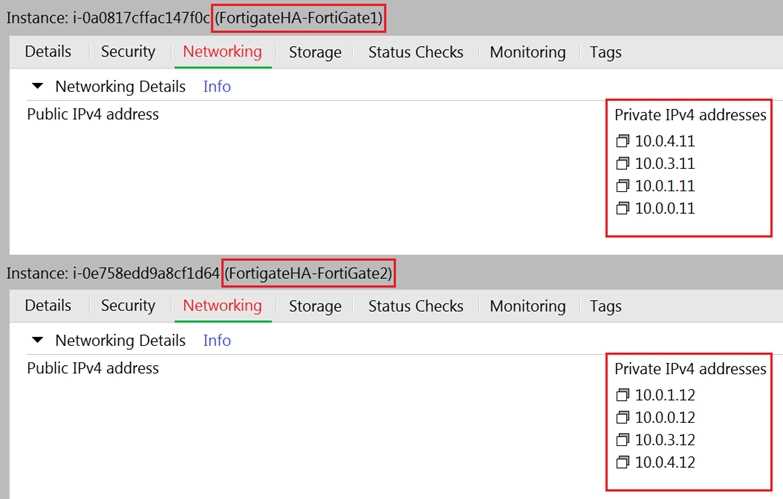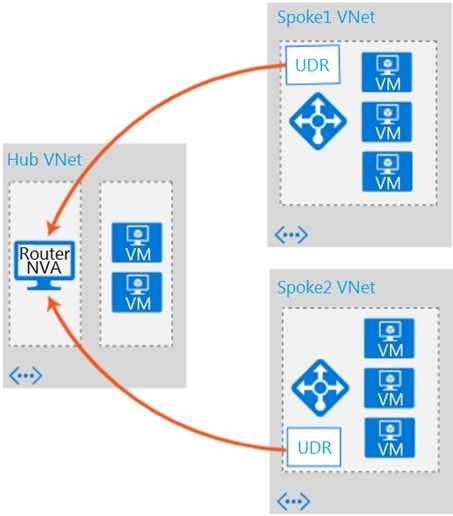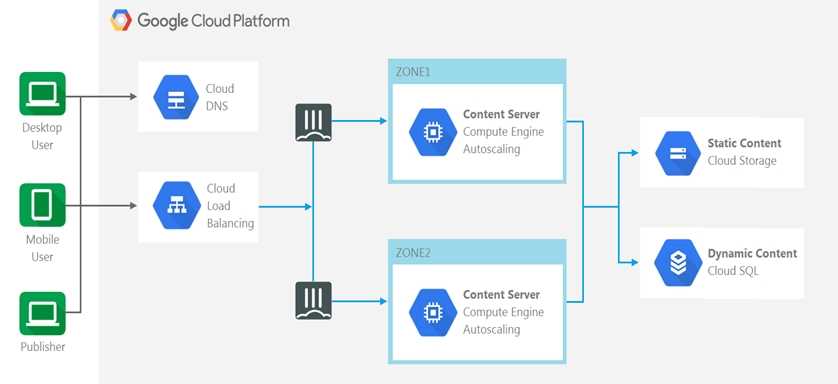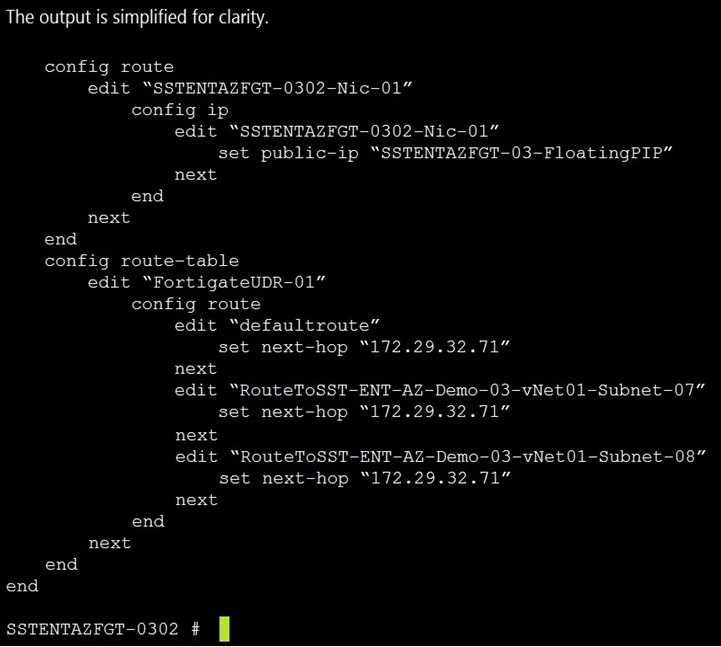Fortinet nse7-pbc-6-4 practice test
Fortinet NSE 7 - Public Cloud Security 6.4 Exam
Question 1
You need to deploy FortiGate VM devices in a highly available topology in the Microsoft Azure cloud.
The following are the requirements of your deployment:
Two FortiGate devices must be deployed; each in a different availability zone.
Each FortiGate requires two virtual network interfaces: one will connect to a public subnet
and the other will connect to a private subnet.
An external Microsoft Azure load balancer will distribute ingress traffic to both FortiGate
devices in an active- active topology.
An internal Microsoft Azure load balancer will distribute egress traffic from protected virtual
machines to both FortiGate devices in an active-active topology.
Traffic should be accepted or denied by a firewall policy in the same way by either FortiGate
device in this topology.
Which FortiOS CLI configuration can help reduce the administrative effort required to maintain the
FortiGate devices, by synchronizing firewall policy and object configuration between the FortiGate
devices?
- A. config system sdn-connector
- B. config system ha
- C. config system auto-scale
- D. config system session-sync
Answer:
B
Reference: https://docs.fortinet.com/document/fortigate/6.2.0/cookbook/84777/using-standalone-
configuration- synchronization
Question 2
Customer XYZ has an ExpressRoute connection from Microsoft Azure to a data center. They want to
secure communication over ExpressRoute, and to install an in-line FortiGate to perform intrusion
prevention system (IPS) and antivirus scanning.
Which three methods can the customer use to ensure that all traffic from the data center is sent
through FortiGate over ExpressRoute? (Choose three.)
- A. Install FortiGate in Azure and build a VPN tunnel to the data center over ExpressRoute
- B. Configure a user-defined route table
- C. Enable the redirect option in ExpressRoute to send data center traffic to a user-defined route table
- D. Configure the gateway subnet as the subnet in the user-defined route table
- E. Define a default route where the next hop IP is the FortiGate WAN interface
Answer:
CDE
Question 3
Refer to the exhibit.
You are configuring an active-passive FortiGate clustering protocol (FGCP) HA configuration in a
single availability zone in Amazon Web Services (AWS), using a cloud formation template.
After deploying the template, you notice that the AWS console has IP information listed in the
FortiGate VM firewalls in the HA configuration. However, within the configuration of FortiOS, you
notice that port1 is using an IP of 10.0.0.13, and port2 is using an IP of 10.0.1.13.
What should you do to correct this issue?
- A. Configure FortiOS to use static IP addresses with the IP addresses reflected in the ENI primary IP address configuration (as per the exhibit).
- B. Delete the deployment and start again. You have in put the wrong parameters during the cloud formation template deployment.
- C. Configure FortiOS to use DHCP so that it will get the correct IP addresses on the ports.
- D. Nothing, in AWS cloud, it is normal for a FortiGate ENI primary IP address to be different than the FortiOS IP address configuration.
Answer:
C
Question 4
Which statement about FortiSandbox in Amazon Web Services (AWS) is true?
- A. In AWS, virtual machines (VMs) that inspect files do not have to be reset after inspecting a file.
- B. FortiSandbox in AWS uses Windows virtual machines (VMs) to inspect files.
- C. In AWS, virtual machines (VMs) that inspect files are constantly up and running.
- D. FortiSandbox in AWS can have a maximum of eight virtual machines (VMs) that inspect files.
Answer:
C
Question 5
You have been asked to develop an Azure Resource Manager infrastructure as a code template for
the FortiGate-VM, that can be reused for multiple deployments. The deployment fails, and errors
point to the storageAccount name.
Which two are restrictions for a storageAccount name in an Azure Resource Manager template?
(Choose two.)
- A. The uniqueString() function must be used.
- B. The storageAccount name must use special characters.
- C. The storageAccount name must be in lowercase.
- D. The storageAccount name must contain between 3 and 24 alphanumeric characters.
Answer:
AC
Question 6
An organization deployed a FortiGate-VM in the Google Cloud Platform and initially configured it
with two vNICs. Now, the same organization wants to add additional vNICs to this existing FortiGate-
VM to support different workloads in their environment.
How can they do this?
- A. They can create additional vNICs using the Cloud Shell.
- B. They cannot create and add additional vNICs to an existing FortiGate-VM.
- C. They can create additional vNICs in the UI console.
- D. They can use the Compute Engine API Explorer.
Answer:
D
Reference: https://fortinetweb.s3.amazonaws.com/docs.fortinet.com/v2/attachments/62d32ecf-
687f-11ea- 9384-00505692583a/FortiOS-6.4-GCP_Cookbook.pdf
Question 7
Refer to the exhibit.
Which two conditions will enable you to segregate and secure the traffic between the hub and the
spokes in Microsoft Azure? (Choose two.)
- A. Implement the FortiGate-VM network virtual appliance (NVA) in the hub and use user-defined routes (UDRs) in the spokes.
- B. Use ExpressRoute to interconnect the hub VNets and spoke VNets.
- C. Configure VNet peering between the spokes only.
- D. Configure VNet peering between the hub and spokes.
Answer:
BD
Question 8
Refer to the exhibit.
The exhibit shows a topology where multiple connections from clients to the same FortiGate-VM
instance, regardless of the protocol being used, are required.
Which two statements are correct? (Choose two.)
- A. The design shows an active-active FortiGate-VM architecture.
- B. The Cloud Load Balancer Session Affinity setting should be changed to CLIENT_IP.
- C. The design shows an active-passive FortiGate-VM architecture.
- D. The Cloud Load Balancer Session Affinity setting should use the default value.
Answer:
AB
Question 9
An organization deploys a FortiGate-VM (VM04 / c4.xlarge) in Amazon Web Services (AWS) and
configures two elastic network interfaces (ENIs). Now, the same organization wants to add additional
ENIs to support different workloads in their environment.
Which action can you take to accomplish this?
- A. None, you cannot create and add additional ENIs to an existing FortiGate-VM.
- B. Create the ENI, shut down FortiGate, attach the ENI to FortiGate, and then start FortiGate.
- C. Create the ENI, attach it to FortiGate, and then restart FortiGate.
- D. Create the ENI and attach it to FortiGate.
Answer:
B
Reference: https://fortinetweb.s3.amazonaws.com/docs.fortinet.com/v2/attachments/9e3b59dc-
ba0b-11e9- a989-00505692583a/FortiOS_6.2_AWS_Cookbook.pdf
Question 10
Which two statements about Amazon Web Services (AWS) networking are correct? (Choose two.)
- A. Proxy ARP entries are disregarded.
- B. 802.1q VLAN tags are allowed inside the same virtual private cloud.
- C. AWS DNS reserves the first host IP address of each subnet.
- D. Multicast traffic is not allowed.
Answer:
CD
Reference: https://docs.aws.amazon.com/sdkfornet/v3/apidocs/items/EC2/TIEC2.html
Question 11
You have previously deployed an Amazon Web Services (AWS) transit virtual private cloud (VPC) with
a pair of FortiGate firewalls (VM04 / c4.xlarge) as your security perimeter. You are beginning to see
high CPU usage on the FortiGate instances.
Which action will fix this issue?
- A. Convert the c4.xlarge instances to m4.xlarge instances.
- B. Migrate the transit VPNs to new and larger instances (VM08 / c4.2xlarge).
- C. Convert from IPsec tunnels to generic routing encapsulation (GRE) tunnels, for the VPC peering connections.
- D. Convert the transit VPC firewalls into an auto-scaling group and launch additional EC2 instances in that group.
Answer:
D
Question 12
Which two Amazon Web Services (AWS) topologies support east-west traffic inspection within the
AWS cloud
by the FortiGate VM? (Choose two.)
- A. A single VPC deployment with multiple subnets and a NAT gateway
- B. A single VPC deployment with multiple subnets
- C. A multiple VPC deployment utilizing a transit VPC topology
- D. A multiple VPC deployment utilizing a transit gateway
Answer:
BC
Reference: https://www.fortinet.com/content/dam/fortinet/assets/white-papers/wp-aws-reference-
architecture.pdf
Question 13
Refer to the exhibit.
Consider an active-passive HA deployment in Microsoft Azure. The exhibit shows an excerpt from the
passive FortiGate-VM node.
If the active FortiGate-VM fails, what are the results of the API calls made by the FortiGate named
SSTENTAZFGT-0302? (Choose two.)
- A. SSTENTAZFGT-03-FloatingPIP is assigned to the IP configuration with the name SSTENTAZFGT- 0302-Nic-01, under the network interface SSTENTAZFGT-0302-Nic-01
- B. 172.29.32.71 is set as a next hop IP for all routes under FortigateUDR-01
- C. The network interface of the active unit moves to itself
- D. SSTENTAZFGT-03-FloatingPIP public IP is assigned to NIC SSTENTAZFGT-0302-Nic-01
Answer:
AB
Question 14
Your company deploys FortiGate VM devices in high availability (HA) (active-active) mode with
Microsoft Azure load balancers using the Microsoft Azure ARM template. Your senior administrator
instructs you to connect to one of the FortiGate devices and configure the necessary firewall rules.
However, you are not sure now to obtain the correct public IP address of the deployed FortiGate VM
and identify the access ports.
How do you obtain the public IP address of the FortiGate VM and identify the correct ports to access
the device?
- A. In the configured load balancer, access the inbound NAT rules section.
- B. In the configured load balancer, access the backend pools section.
- C. In the configured load balancer, access the inbound and outbound NAT rules section.
- D. In the configured load balancer, access the health probes section.
Answer:
C
Reference: https://www.fortinet.com/content/dam/fortinet/assets/deployment-guides/dg-fortigate-
high- availability-azure.pdf
Question 15
You have been asked to secure your organizations salesforce application that is running on Microsoft
Azure, and find an effective method for inspecting shadow IT activities in the organization. After an
initial investigation, you find that many users access the salesforce application remotely as well as
on-premises.
Your goal is to find a way to get more visibility, control over shadow IT-related activities, and identify
any data leaks in the salesforce application.
Which three steps should you take to achieve your goal? (Choose three.)
- A. Deploy and configure FortiCASB with a Fortinet FortiCASB subscription license.
- B. Configure FortiCASB and set up access rights, privileges, and data protection policies.
- C. Use FortiGate, FortiGuard, and FortiAnalyzer solutions.
- D. Deploy and configure FortiCWP with a workload guardian license.
- E. Deploy and configure FortiGate with Security Fabric solutions, and FortiCWP with a storage guardian advance license.
Answer:
ABC